Ijraset Journal For Research in Applied Science and Engineering Technology
- Home / Ijraset
- On This Page
- Abstract
- Introduction
- Conclusion
- References
- Copyright
Socio-Economic Status of Construction Workers
Authors: Rakesh Samanta, Ananya Punyotoya Parida
DOI Link: https://doi.org/10.22214/ijraset.2022.41507
Certificate: View Certificate
Abstract
This report attempts to analyse a study on the socioeconomic position of construction employees. The income and spending of construction employees have been gathered using an interview schedule. Data were gathered from five different sorts of construction workers: contractors, mastery, masons, and male and female assistance. Data were gathered from 400 respondents, who represented all five categories of construction employees described above. For this objective, structured interview schedules were adopted. For the five distinct sorts of construction employees, different timetables were adopted.
Introduction
I. INTRODUCTION
Privatization has been a hotly discussed issue among academics and policymakers for decades. This study will evaluate the outcomes of the largest privatisation initiative in the construction industry. Privatization as an idea has dominated the global economic reform landscape for the previous three decades. The concept gained traction, with more1than eighty nations implementing privatisation programmes & more than 65001state-owned enterprises being privatised (Hinnawi & Ahmed, 1995). As an effective tool for economic change, phenomenon expanded from United Kingdom, pioneer in privatisation, to smaller economies & less developed1countries. Privatization is a philosophical approach that involves broadening ownership base1of State Owned Enterprises by selling or leasing assets, creating partnerships, or contracting1out management. In most situations, privatisation transition will result in more efficient firm operations due to changes in company objectives and market demands on managers to enhance performance. As a result, this will be reflected in company profitability and the maximum of shareholder value. As a result, it is apparent that privatisation may play an important part in1any economic reform1programme.
The government's decision1to undertake a privatisation programme will almost definitely contain a stated set of1objectives that must be reached through use of this economic reform tool. The following are key aims of any privatisation scheme (Eytan Sheshinski & Luis F. López-Calva12003):
- To reduce overall budget1deficit
- To create1competitive markets
- To extend ownership1base
- To develop1capital markets
The building business is spread out around the globe. It generates a big number of jobs. Construction activity has grown in importance in terms of job creation during the last five years, thanks to successive five-year plans. Because of modernization and recent advances, this industry is playing an important part in construction of1buildings, roads, bridges, & so on. Workers in this business are subjected to a variety of occupational diseases and psychological pressures. They are classified as organised or unorganised in India.
However, statistics on occupational health and psychological strees in our nation are limited. True, the unorganised sectors employ a substantial proportion of the workers.
The working hrs are longer than permitted hrs of work –working environment is unsanitary –working circumstances are unfavourable in1most situations and entail risk concerns Their incomes are insufficient as well, making it difficult1for them to support their1families. Handling various materials necessary for building, as well as exposure to hazardous weather conditions such as sun, rain, and so on, are among the risks. As a result, in harsh conditions, accidents occur, and adverse health problems generate psychological pressure and the like. They suffer from headaches, backaches, joint problems, skin illnesses, lung ailments such as silicosis, and various Muscular Skeletal Disorders, among other things. Boredom is caused by the repetitious nature of the task, & disproportionate income relative to needs puts them1under psychological stress & pressure, as well as other aberrant behavioural problems.
According to this report, sponsored by PWC, the volume of building production would increase by more1than 70 percent to $ 15 trillion globally by12025. The1meteoric rise that outpaces1global GDP will be centred in 3 countries: China, United States, & India.
a. China, India, & the United States will1account for about 60 percent of global1growth.
b. Emerging Asian1markets profiting from China's1slowdown
c. Western Europe's construction market will be about 5 percent smaller by 2025 than it was in 2007.
The global construction sector has already reached a tipping1point, with emerging countries accounting for 52% of all construction activity today. This is expected to climb to 63 percent by 2025, with China & India driving majority of development in developing countries. China surpassed United States to become world's largest construction market in 2010, & despite an expected recession, it is forecast to increase its global share from 18 percent to 26 percent by 2025. Significant prospects for next generation of 'Asian Tigers' have surfaced. The Philippines, Indonesia, & Vietnam are becoming increasingly tempting. For export-oriented manufacturing & a $350 billion construction industry growing at a pace of more than 6% per year.
II. LITERATURE REVIEW
Gadekar and Pimplikar (2015) investigated the elements that contribute to the success & failure of Indian1construction firms. A study was conducted among thirty construction firms. The point rating procedures were used to establish the ranking of the criteria. According to research findings, cash flow1management, insufficient1capital, & insufficient sales are most critical elements for success of1construction enterprises in the big, medium, & small size organisations, respectively.
Steve Williamson (2015) examined the economic significance of the construction industry. Every country's construction sector is a key collaborator and driver of economic progress. In truth, the building industry's most significant contribution is infrastructure. The heart of economic progress is infrastructure. The state of a country's infrastructure has a direct impact on its economy, because infrastructure is the vital cogwheel that allows commerce to take place.
A research on construction workers in Mexico was done by Romel G. Solis-Carcarioo and Ricardo J. Franco-Poot (2014). The study's goal is to examine construction workers' perceptions of safety. It is clear that organisational features and worker perceptions are two of the most important elements influencing the safety atmosphere on construction sites. Although1some of employees' perspectives may appear ludicrous to outsiders, these elements are a part of1their reality.
Agung and Wibowo (2014) conducted research on the construction industry's impact to the Indonesian economy. This research looks at the effort done to establish the specific benefits of investing in building. The consequences under consideration are those on the micro and macroeconomics of those engaged directly or indirectly in the construction sector.
Thayyil Jayakrishnan, et al. (2013) investigated construction workers' occupational health concerns in India. Construction workers are more likely than those in other sectors to have certain health issues and illnesses. The purpose of this research is to better understand occupational health concerns of construction employees in building & civil industries, as well as to compare morbidities between these two groups of workers.
Russel Lawson (2013) conducted research on the value of the construction industry to the entire economy. According to the findings of this study, the construction sector is critical to the economy's competitiveness and success. A contemporary, efficient infrastructure is a critical component for productivity, and the construction sector plays a significant role in supplying physical infrastructure in an innovative and cost-effective manner.
A research on Strong women with Weak bodies was undertaken by Aaradhana Dalmia (2012). Women Construction Workers in Delhi with Muffled Voices The goal of this research was to understand the role of a migratory community of female construction workers in a changing city and to bring their voices and experiences to light. The lives of women construction workers in Delhi are riddled with obstacles.
Arumugam (2012) conducted research on the socioeconomic position of workers in the building construction business. The study's goal is to learn about the socioeconomic position of construction workers and how they use social security. The study included ten workers with an1average age of 32 yrs & a mean job duration of nine yrs. They were poorly compensated, with an average monthly salary of Rs.4956/-.
Guddi et al. (2012) did a study on the socioeconomic position of building construction employees. The study included 150 sample respondents in Salt Lake City, Kolkata, West Bengal, with an1average age of 32 yrs & a work experience of nine yrs. They were poorly compensated, with an average monthly salary of Rs.4956/-. The literacy rate was rather high (79 percent ). The majority of them were addicted to various substances such as alcohol, beedi, tobacco chewing, and other intoxicants.
III. SOCIO ECONOMIC STATUS OF CONSTRUCTION WORKERS
Table 1 Category Wise Classifications of Construction Workers
|
Designation |
Gender |
Total |
|
|
Male |
Female |
||
|
Contractors |
40 (100) |
- |
40 (10.0) |
|
Mastery |
79 (100) |
- |
79 (19.8) |
|
Mason |
145 (100) |
- |
145 (36.2) |
|
Helpers |
62 (45.6) |
74 (54.4) |
136 (34.0) |
|
Total |
326 (81.5) |
74 (18.5) |
400 (100) |
According to Table 2, 81.5 percent of construction employees are male, while the remaining 18.5 percent are female. In terms of labour classification, 36.2% of responders are masons, 34% are assistants, 19.8% are mastery, and 10% are contractors.
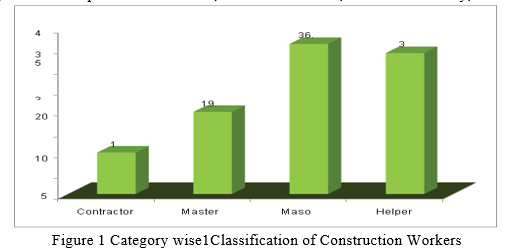
IV. AGE STRUCTURE OF CONSTRUCTIONIWORKERS
Construction workers of all ages have been participating in the task. Age is not an impediment to working in the construction industry. The age distribution of the sample responses indicates the age distribution of construction employees. The age of the construction employees was also collected in order to establish its effect on their choice of construction workers. A study was conducted to determine the age range of the construction employees. The age structure of construction employees is depicted in the table below.
Table 2 Age Structure of Construction1Workers
|
Age Group |
Designation of Construction Workers |
Total |
||||
|
Contractors |
Mastery |
Mason |
Male Helpers |
Female Helpers |
||
|
Below 25 |
04 (10.0) |
08 (10.1) |
17 (11.7) |
18 (29.0) |
05 (6.8) |
52 (13.0) |
|
26-35 |
10 (25.0) |
31 (39.2) |
74 (51.0) |
22 (35.5) |
17 (22.9) |
154 (38.5) |
|
36-45 |
15 (37.5) |
26 (32.9) |
30 (20.7) |
10 (16.1) |
4 (5.4) |
85 (21.3) |
|
46-55 |
9 (22.5) |
10 (12.7) |
17 (11.8) |
7 (11.3) |
44 (59.5) |
87 (21.7) |
|
Above 55 |
2 (5.0) |
4 (5.1) |
7 (4.8) |
5 (8.1) |
4 (5.4) |
22 (5.5) |
|
Total |
40 |
79 |
145 |
62 |
74 |
400 (100) |
According to this data, construction employees range in age from less than 25 to more than 55 years. The highest number (38.5 percent) of 400 responders are between the ages of 26 and 35. The majority of responses in the mastering, mason, and male assistance categories are between the ages of 26 and 35, with 39.2 percent, 51 percent, and 35.5 percent, respectively. Among contractors, the greatest group (37.5 percent) of respondents are between the ages of 36 and 45, whereas among female1helpers, largest group (59.5 percent) of respondents1are between ages of 46 and 55.
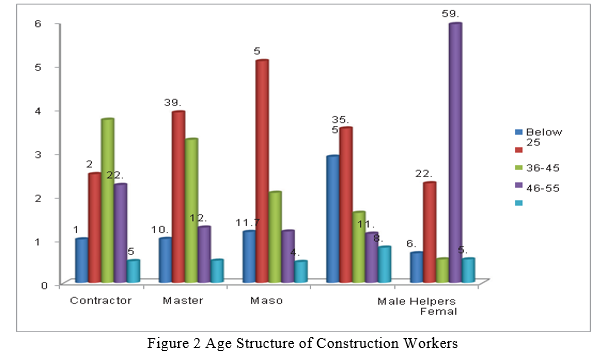
V. CASTE-WISE CLASSIFICATION
Caste distribution is an essential sociological component that determines people's social standing and culture in emerging nations like India. The table below depicts the distribution of construction employees by caste.
Table 3 Caste wise Classification of Construction Workers
|
Caste |
Designation1of Construction1Workers |
Total |
||||
|
Contractors |
Mastery |
Mason |
Male Helpers |
Female Helpers |
||
|
OC |
3 (7.5) |
18 (22.8) |
7 (4.8) |
2 (3.2) |
2 (2.7) |
32 (8.0) |
|
OBC |
19 (47.5) |
37 (46.8) |
63 (43.5) |
9 (14.5) |
8 (10.8) |
136 (34.0) |
|
MBC |
14 (35.0) |
13 (16.5) |
41 (28.3) |
6 (9.7) |
7 (9.5) |
81 (20.3) |
|
SC |
4 (10) |
11 (13.9) |
34 (23.4) |
45 (72.6) |
57 (77.0) |
151 (37.7) |
|
Total |
40 |
79 |
145 |
62 |
74 |
400(100) |
According to this table, SC has the highest proportion (37.7 percent) of the 400 respondents. OBC has the highest percentage of responders among contractors, mastery, and masons, with 47.5 percent, 46.8 percent, and 43.5 percent, respectively. SC has the highest proportion of male and female assistance, 72.6 percent and 77 percent, respectively.
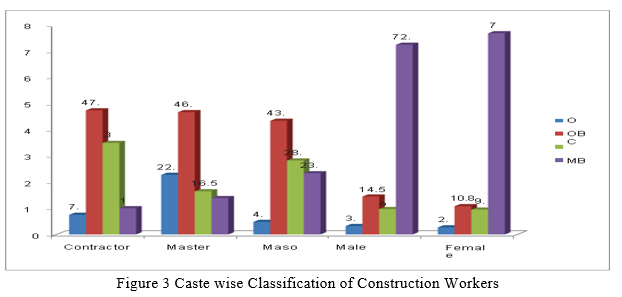
VI. RELIGION-WISE CLASSIFICATION
Construction workers of several religions have been participating in the work. Religion has a significant impact on people's familial and economic lives. Because religious holidays have an influence on people's social lives, the religion of construction workers is being researched. Religion is a significant social aspect that influences people's lifestyles. The majority of construction employees in the research region are Hindu. Table 4 describes the religion of the various designations of construction employees in the research region.
Table 4 Religion wise1Classification of Construction1Workers
|
Religion |
Designation1of Construction1Workers |
Total |
||||
|
Contractors |
Mastery |
Mason |
Male Helpers |
Female Helpers |
||
|
Hindu |
30 (75.0) |
39 (49.4) |
112 (77.2) |
46 (74.2) |
36 (48.6) |
263 (65.8) |
|
Christian |
6 (15.0) |
28 (35.4) |
30 (20.7) |
14 (22.6) |
38 (51.4) |
116 (29.0) |
|
Muslim |
4 (10.0) |
12 (15.2) |
3 (2.1) |
2 (3.2) |
- |
21 (5.2) |
|
Total |
40 |
79 |
145 |
62 |
74 |
400(100) |
According to this table, the highest percentage (65.8 percent) of the 400 respondents are Hindu. The greatest groupings of responders are Hindu, with 75 percent, 49.4 percent, 77.2 percent, and 74.2 percent, respectively, among contractors, mastery, mason, and male assistants. Christians make up the biggest group of responders among female caregivers, accounting for 51.4 percent.
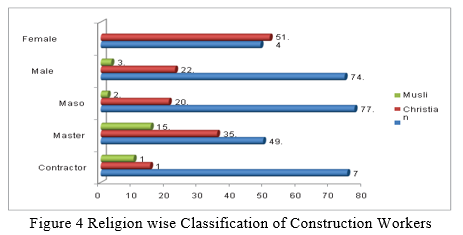
VII. EDUCATIONAL STATUS WISE CLASSIFICATION OF SAMPLE RESPONDENTS
Literacy and educational achievement are seen as important variables determining any society's socioeconomic progress. The degree of educational attainment can be used to assess a society's quality. Because education has a significant influence in the development of money. Education has a significant influence on people's social and economic lives. In a democratic system, it makes citizens immensely responsible. Education improves understanding of labour and industry, increasing productivity. As a result, the educational level of construction employees has been investigated. The educational status of construction employees is shown in the table below.
Table 5 Educational Status of different designation of Construction1Workers
|
Educational Status |
Designation1of Construction1Workers |
Total |
||||
|
Contractors |
Mastery |
Mason |
Male Helpers |
Female Helpers |
||
|
Primary |
3 (7.5) |
22 (27.8) |
49 (33.8) |
24 (38.7) |
36 (48.7) |
134 (33.5) |
|
Secondary |
14 (35.0) |
15 (19.0) |
82 (56.6) |
29 (46.8) |
34 (45.9) |
174 (43.5) |
|
Degree |
21 (52.5) |
34 (43.1) |
10 (6.9) |
6 (9.7) |
- |
71 (17.7) |
|
Uneducated |
2 (5.0) |
8 (10.1) |
4 (2.7) |
3 (4.8) |
4 (5.4) |
21 (5.3) |
|
Total |
40 |
79 |
145 |
62 |
74 |
400(100) |
According to this table, the majority of the 400 respondents (43.5 percent) had finished secondary school. The majority of contractors and mastery responders had finished a degree, with 52.5 percent and 43.1 percent, respectively. The majority of masons and male assistants have completed secondary school, with 56.6 percent and 46.8 percent, respectively, having completed secondary school. The majority of female caregivers have finished primary school, accounting for 48.7 percent of those polled.
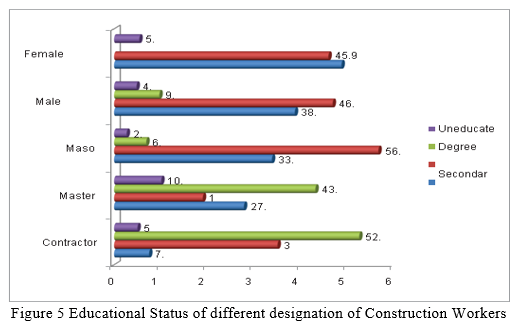
VIII. NATURE OF THE FAMILY
The system of a family is referred to as its family structure. The joint family is a custom that offers both sociological and economic benefits for the members of the family. People who are educated and cultured desire to have a nuclear family as soon as they start earning money. The family system prevalent among construction workers is detailed in the tables below.
Table 6 Nature of the Family of different designation of Construction1Workers
|
Family |
Designation1of Construction1Workers |
Total |
||||
|
Contractors |
Mastery |
Mason |
Male Helpers |
Female Helpers |
||
|
Joint |
15 (37.5) |
60 (75.95) |
90 (62.07) |
30 (48.39) |
54 (72.97) |
249 (62.25) |
|
Nuclear |
25 (62.5) |
19 (24.05) |
55 (37.93) |
32 (51.61) |
20 (27.03) |
151 (37.75) |
|
Total |
40 |
79 |
145 |
62 |
74 |
400(100) |
According to the above data, 62.25 percent of the sample respondents are members of a joint family, while the remaining 37.75 percent are members of a nuclear family. The table above demonstrates that the majority of respondents are part of a combined family arrangement.
IX. MARITAL STATUS
Marriage, as a socioeconomic institution, is equally important in the working society. Marriage brings with it both possibilities and problems. Certain requirements to labour, earn, and save arise. The marital status of construction employees is detailed in the tables below.
Table 7 Marital Status of the different designation of Construction1Workers
|
Marital Status |
Designation1of Construction1Workers |
Total |
||||
|
Contractors |
Mastery |
Mason |
Male Helpers |
Female Helpers |
||
|
Married |
35 (87.5) |
70 (88.61) |
99 (68.28) |
50 (80.65) |
65 (87.84) |
319 (79.75) |
|
Unmarried |
5 (12.5) |
9 (11.39) |
46 (31.72) |
12 (19.35) |
9 (12.16) |
81 (20.25) |
|
Total |
40 |
79 |
145 |
62 |
74 |
400(100) |
According to this table, the majority of the 400 respondents, 79.75 percent, are married, while the remaining 20.25 percent are unmarried. It is apparent that the majority of responders are married.
X. MONTHLYIINCOME OF THEIFAMILY
The wages of a construction1worker are extremely important in determining the level of life of construction worker's family. A construction1worker's household earns money not just through building labour, but also from various associated industries such as business, agriculture, and government work. The monthly income of a construction worker's family is shown in the table below.
Table 4.8 Monthly1Income wise Classification of1Construction Workers
|
Monthly income |
Designation1of Construction Workers |
Total |
||||
|
Contractors |
Mastery |
Mason |
Male Helpers |
Female Helpers |
||
|
Below Rs.10000 |
- |
- |
44 (30.3) |
42 (67.7) |
74 (100) |
160 (40.0) |
|
Rs.10000- 15000 |
6 (15.0) |
31 (39.3) |
79 (54.5) |
20 (32.3) |
- |
136 (34.0) |
|
Rs.15000- 20000 |
9 (22.5) |
37 (46.8) |
22 (15.2) |
- |
- |
68 (17.0) |
|
Above Rs.20000 |
25 (62.5) |
11 (13.9) |
- |
- |
- |
36 (9.0) |
|
Total |
40 |
79 |
145 |
62 |
74 |
400(100) |
According to this table, the majority of 400 respondents (40 percent) had a monthly salary of less than Rs.10,000. The majority of responders (62.5 percent) are contractors who earn more than Rs.20,000 per month. The majority of the respondents (46.8 percent) make a monthly salary of Rs.15,000-20,000. The majority of masons (54.5 percent) make a monthly wage of Rs.10,000-15,000, according to the survey. The majority of male and female assistants make less than Rs.10,000 per month, with 67.7 percent and 100 percent, respectively, earning less than Rs.10,000 per month.
Conclusion
Based on the analysis inferences were drawn and the findings emerged out of the study are- 1) Majority Male construction workers account for 81.5 percent of the workforce. In terms of occupational categorization, 36.2 percent of respondents are masons. 2) It has been shown that the majority (38.5 percent) of Construction Workers are between the ages of 26 and 35. 3) It has been discovered that the majority of responders in the mastering, mason, and male helper categories are between the ages of 26 and 35, with 39.2 percent, 51 percent, and 35.5 percent, respectively. 4) The majority (37.7 percent) of the population is classified as SC. OBC has the highest percentage of responders among contractors, mastery, and masons, with 47.5 percent, 46.8 percent, and 43.5 percent, respectively. 5) It has been shown that the majority (65.8 percent) are Hindu. The greatest groupings of responders are Hindu, with 75 percent, 49.4 percent, 77.2 percent, and 74.2 percent, respectively, among contractors, mastery, mason, and male assistants. 6) The majority (43.5 percent) of Construction Workers have finished secondary school. 7) It has been shown that the majority of Construction Workers (62.25%) are members of a combined family. 8) It has been shown that the majority of construction workers (79.75 percent) are married. 9) The majority of construction workers (40 percent) earn less than Rs.10,000 per month. Sixty-two percent of contractors (62.5 percent) earn more than Rs.20,000 per month. Construction is an unorganised sector, and unorganised employees are those who are unable to organise themselves in their profession. Construction employees\' wages are dictated by market trends, but they should be determined by their talent. Their pay is not commensurate with the amount of labour they do. Workers labour hard to preserve their earnings, and the majority of them put their money in a bank. It demonstrates that, despite finding it difficult1to save money, they do so through bank. The assistants have significant challenges in terms of wage and job security.
References
[1] Gadekar and Pimplikar (2015), Study on Cultivation of Motivation Hygene Factors in Construction Enterprise Applied Mechanics and Materials, Vol.501 – 504, PP 2628 – 2631 [2] Srinivasa Raghavan and Karthik Kumar (2015), Problems faced by Small Scale Construction Contractors in India, International Research Journal of Engineering and Technology, Vol.02, Issue 02, May, PP. 41 – 48. [3] Agung, Wibowo, (2014), Growth of Construction Industry, Construction Management and Economic Vol.7. P.P.27-31. [4] Gadekar and Pimplikar, (2014), Success and Failure Factors of Indian Construction Companies, Published in the International Journal of Engineering and Science, Vol. 3(6), PP.52 – 58. [5] Russel Lawson (2013) Social backwardness of Construction Workers, Woodland Publishers, New Delhi. [6] Gadekar and Pimplikar, (2013), Factors Leading to Success of Indian Construction Companies, Published on Journal of Mechanical and Civil Engineering, Vol. 10(1), PP. 52 – 54. [7] Surapati Pramanik & Sourendranath (2013), A Study on Problems of Construction Workers in West Bengal Based on neutrosophic Cognitive, International Journal of Innovative Research in Scienceand Technology, Vol.2, Issue 11, [8] Aaradhana Dalmia, (2012), Women Construction Workers in Delhi, Rajnat Publishers, Delhi. [9] Arumugam, (2012), Socio-economic Status of Workers of Building Construction Industry in Tamil Nadu, Enian Publishers, Chennai. [10] Guddi et. al. (2012), Socio-economic Status of Workers of Building Construction Industry, Bangalore.
Copyright
Copyright © 2022 Rakesh Samanta, Ananya Punyotoya Parida. This is an open access article distributed under the Creative Commons Attribution License, which permits unrestricted use, distribution, and reproduction in any medium, provided the original work is properly cited.

Download Paper
Paper Id : IJRASET41507
Publish Date : 2022-04-16
ISSN : 2321-9653
Publisher Name : IJRASET
DOI Link : Click Here
 Submit Paper Online
Submit Paper Online

